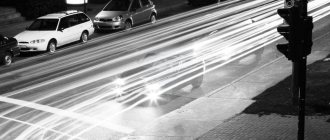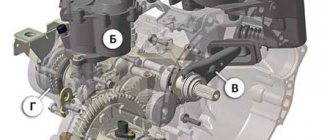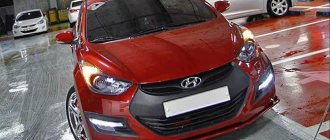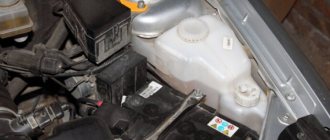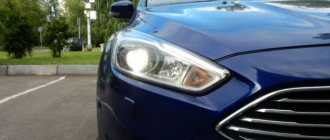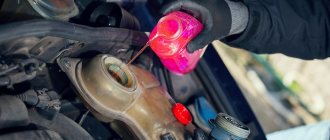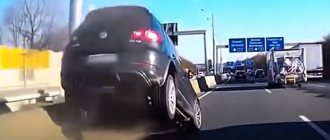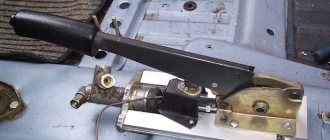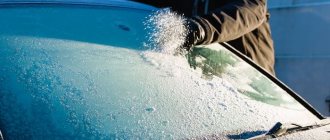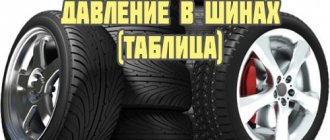A modern car has as many as 8 different lighting devices installed (there is also a backlight for the rear license plate, but in this case we are not interested in it). And we need to use these 7 lighting devices: headlights, flashlights, foglights and other things in different ways, depending on as many as 8 conditions. Let's list lighting devices and conditions for their use for 2022!
So, the car has so-called external lighting devices. These include:
- headlights: low beam;
- headlights: high beam;
- rear lights;
- fog lights (PTF);
- rear fog lights;
- parking lights;
- daytime running lights (DRLs).
And among the conditions for including certain lighting devices in the traffic rules, there are the following:
- daylight hours;
- dark time of day: illuminated road;
- dark time of day: unlit road;
- low visibility conditions;
- standing/moving car;
- trailer/towed vehicle;
- populated/non-populated area.
Are you scared? It's actually not all that scary. Let's find out when and in what cases you need to turn on the headlights, fog lights, high or low beam headlights and dimensions. Data current as of September 6, 2022. For convenience, we will consider the rules for using car lights depending on the time of day and other conditions, and answer some pressing questions. And at the end of the article we will provide a table as a simple way to remember when which lights need to be turned on on the car.
External car lights
At the beginning of this article, a few words about what external lighting devices a car may have. This information is primarily intended for those who are studying at a driving school and do not yet understand what these or other headlights or lanterns are intended for.
Note. The topic “lighting devices” is one of the most difficult in a driving school, because... It is difficult for a driver candidate who has never driven before to remember the similar names of light devices and the rules for their use.
parking lights
Dimensions are small light devices located approximately at the corners of the car (4 pieces in total). They do not shine very brightly and are primarily designed so that drivers of other cars can understand in the dark where your car begins and ends.
As a rule, the car is designed in such a way that when you turn on the low or high beam headlights, the dimensions turn on automatically. That is, low beam without side lights does not work.
Daytime Running Lights
DRLs are light devices in the front of the car (2 pieces), which shine quite brightly. They are designed to improve visibility of the car from the front during daylight hours.
Daytime running lights should not be used at night because... at night, they can blind oncoming drivers due to their high brightness. However, they do not illuminate the road.
We recommend: What to do if the fan of the VAZ-2112 stove does not work
In 2022, most cars are equipped with daytime running lights, but such lights are quite rare on cars manufactured before 2010.
Low and high beam headlights
Low beam (2 bulbs) and high beam (2 bulbs) headlights are the main lighting devices that are designed to illuminate the road in front of the car.
In this case, the low beam illuminates the area directly in front of the car, and the high beam illuminates a more distant area. It makes sense to use low beam at low speeds, high beam at higher speeds.
Fog lights
PTF - 2 headlights in the front bumper of a car, designed to illuminate the road in poor visibility conditions.
Fog lights are optional for 2022, so not all vehicle trim levels have them. That is, the car may not have PTF.
Fog light
Fog light - a red light at the rear of the vehicle, designed to improve visibility of the vehicle in poor visibility conditions. This light device is very bright and in good weather it can blind drivers of cars behind.
This lamp is required to be installed on all cars.
How is a violation recorded?
The issue of imposing a fine for not turning on the low beams is dealt with by traffic police officers from the moment the violation is detected until the punishment is imposed.
As a rule, after identifying a violation on the spot, a resolution on administrative liability is drawn up.
Not in all cases you should agree with the traffic police officer.
You can prove a traffic violation for low beam headlights during the day if:
- there are witnesses to the offense;
- driving recorded on video;
- The driver himself admits his guilt.
Therefore, if no evidence is presented, the driver can safely defend his truth. Such materials are easily challenged in court.
If the fact of a violation is undeniable, one should strive to reduce everything to a warning. That is, do not conflict, talk about driving without a penalty, remind about the possibility of warning, etc.
Light and sound devices of the car and their location
We should start with the basics, or rather with what types of headlights and lanterns modern cars are equipped with.
- Low beam headlights - designed to illuminate the road and surrounding area in a relatively small area.
- High beam headlights are powerful lighting devices that illuminate the roadway over a fairly large area. Due to its high brightness, high beams can blind oncoming drivers.
- Front fog lights - installed lower than conventional headlights, create a wide beam of light that well illuminates the road and the surrounding area in conditions of fog, snowfall and rain.
- Daytime running lights are a separate type of headlights that are turned on during the day, regardless of weather or visibility, and are designed to increase the visibility of vehicles. Most models turn on immediately when the engine starts.
- Tail lights - designed to identify the vehicle at night or in poor visibility conditions. The color of the lamps is red.
- Brake lights are red lights that come on when a vehicle slows down. They burn much brighter than the side lights. Some cars are additionally equipped with a central brake light.
- Rear fog lights - indicate the vehicle in fog, rain or snowstorm conditions. Not to be confused with brake lights.
- Reversing lights are white and are designed to inform pedestrians and other motorists that the vehicle will be moving (or is already moving) in reverse.
- Rear reflectors - used for the same purpose as side lights, they reflect the light falling on them from the headlights of passing cars. May also be known as retroreflectors.
- License plate lighting – several white bulbs designed to illuminate the rear license plate of a vehicle.
- Turn signals, or “turn signals,” are amber lights that are used to inform you that the vehicle is turning or otherwise maneuvering. Installed in the corners and on the sides of the car.
Cancel the use of low beam
Recently, changes have often been made to traffic rules, so many drivers have a question: do they need to turn on headlights during the day in the city from 2022?
Indeed, the traffic rules have undergone a number of changes, but this did not affect the procedure for using lighting devices. Therefore, all this is from the category of rumors and assumptions.
So far there are no prerequisites for this. The obligation to use headlights during the day has existed for 8 years. And this has only a positive effect.
Perhaps this need will be canceled. To do this, an official document will be published that will contain information from what date you can not turn on the low beam.
What color of side lights is allowed according to traffic regulations?
If the color of the light device does not meet the standard requirements established for the type of vehicle, the traffic regulations prohibit the operation of such a vehicle.
Requirements for external lighting of vehicles are established by GOST 8769-75. The terms of the standard determine that the front dimensions must emit a white color, and the rear dimensions must emit a red color (Clause 2.5.6).
We recommend: Selecting and changing the fog lamp bulbs yourself
Requirements for the color of side markers are established by GOST R 41.91-99: it must be yellow.
Put a lamp in the headlight and forget about it? Choose Ultra Life!
OSRAM Ultra Life halogen lamps are designed to provide the longest service life possible for halogen automotive lamps. Their luminous flux is standard, but they will work four times longer than conventional lamps . In addition, these are the only halogen lamps that come with a 4-year OSRAM warranty. An ideal choice for drivers who want to install lamps in their headlights and never think about them again!
Hazard lights: what they are for and when to turn them on
The so-called “emergency light” is also a combination of the operation of several lighting devices, and therefore belongs to the section in the traffic regulations that regulates the use of various modes of operation of car headlights. What should you consider when activating the emergency alarm mode?
The very first thing is, of course, emergency situations in which not only emergency lights are involved, but also an emergency stop sign. The latter must always be in your trunk, otherwise you will violate traffic rules. Regardless of where the emergency breakdown of your car occurred, in a vacant lot or on the highway, you need to protect yourself and other road users by marking your car in accordance with the traffic rules. A warning triangle is installed on the route to your car 15 or 30 meters from it, depending on the location of the breakdown.
When can you use the emergency lights?
Hazard alarms are also considered a lighting device, and traffic regulations clearly regulate the possibility of their use. So, the emergency lights need to be turned on:
- if you get into an accident along with a warning triangle (2.5 traffic rules + 7.1 traffic rules);
- if a situation arises where your car poses a danger;
- when forced to stop in a place where stopping is prohibited (together with an emergency stop sign);
- when towing on a towed vehicle;
- if you are blinded by oncoming traffic.
Stopping and parking a car
At night on an unlit road
Must be included:
- parking lights.
It is prohibited to use:
- fog lamp.
Other lighting devices can be used.
In case of insufficient visibility (during dark or daylight)
Must be included:
- parking lights.
Other lights, including the rear fog lamp, may be used.
Why are headlights needed during the day?
There are several reasons why you should turn on a lighting fixture:
- Often a traffic police officer stops a driver because the lights are out. And, in addition to a fine for driving without headlights, this becomes a reason to look for other violations;
- Of course, this is a security issue. Both the other driver and the pedestrian see you. This will avoid many troubles on the road;
- When the lights are on, the instrument panel in the cabin also lights up. Such information is important for the motorist.
Rules for using external lighting devices at night
At night, or the dark time of the day, the rules refer to the period of time between the end of the evening and the beginning of the morning twilight. In such conditions, it is mandatory to turn on the headlights and side lights.
The choice of low or high beam depends on the following nuances:
- If you are driving along illuminated roads in a populated area , you cannot use high beams, only low beams.
- When approaching a vehicle moving in the oncoming lane, the high beams should be switched to low beams at least 150 meters in advance - this way you will not blind the other driver. It’s even better to switch at 200-250 meters.
- If an oncoming vehicle signals by switching or flashing its headlights at a greater distance , turn off the high beams. In such situations, your headlights are most likely poorly adjusted, and they do not so much illuminate the road as they shine into the eyes of oncoming drivers.
- You also need to switch the lights in other situations when there is a threat of blinding other drivers , both oncoming and passing.
What to do if you are blinded? The main thing is not to change lanes, otherwise there is a risk of getting into an accident, hitting a pedestrian or falling into a ditch. The rules require in such a situation to turn on the hazard warning lights, gradually reduce speed and, if necessary, stop.
We recommend: Everything you need to know about the operation of the fuel pump in a VAZ 2106 car
Forced stop in the dark - be sure to turn on the side lights and, if desired, supplement them with low beams and fog lights.
Do you prefer stylish, cool headlights? Then you need other lamps!
make the appearance of your car more stylish and modern . Their glow temperature is up to 5000 K , which is similar to the hue of xenon lamps . This is achieved by applying a blue filter to the bulb of the lamp, which blocks the red range of the emitted light and the color turns out whiter. OSRAM Cool Blue Intense halogen automotive lamps are ideal for use in headlights with clear lenses - the silver dome of these lamps optically merges with the reflector, resulting in an overall homogeneous composition.
When to turn it on and off
All cars have different design solutions for external lighting.
To move on to using the dimensions, you need to clearly know how they turn on and where the controls for these devices are located. This information is detailed in the vehicle's owner's manual.
Sometimes they simply forget about including dimensions. In older cars, this option was turned on simultaneously with the backlight; it was technically impossible to forget.
In modern vehicles, everything is separate: both lighting and dimensions. Turning the optics on and off in certain situations needs to be controlled.
Clause 19.3 of the traffic rules provides for the driver’s obligation to turn on the side lights in the following cases:
- When stopping (parking) at night on unlit road sections.
- In conditions of poor visibility. Additionally, simultaneous activation of daytime running lights, low beam headlights, and fog lights (headlights and rear lights) is allowed.
A significant decrease in visibility occurs under the following conditions:
- in heavy fog;
- at night and at dusk;
- during precipitation, snow or rain;
- when driving in a tunnel.
In conditions of limited visibility when stopping and parking, the driver is given the right to independently decide how to make the car more visible, which lighting devices need to be turned on additionally.
At the same time, we must not forget: even in difficult weather conditions, the choice of a place to stop and park is regulated by the Traffic Rules.
It is believed that movement is most difficult in the dark and in heavy fog. Don't wait until the fog makes the road indistinguishable.
It is better to turn on the lights even in light fog.
When stopping at night on the side of the road, to improve visibility, in addition to the side lights, you should turn on the hazard warning lights.
It’s better to make a rule for yourself: if it becomes worse to see, you need to turn on the dimensions. Do not forget that all drivers have different vision. It is really necessary to indicate the dimensions of the car, because in the dark a car without dimensions is just a ghost.
And also, practical advice: if the low beam of the headlights becomes visible on the road, it’s time to use the side lights.
Rules of paragraphs 6 and 7 of Article 19
Rotating lighting devices (called a spotlight or searchlight) are turned on, according to paragraph 6, only outside the city or other populated area and only when there is no oncoming traffic. The exception is specialized vehicles moving around the territory of a populated area with flashing blue lights, accompanied by sound signals established by the rules. This vehicle must move in the direction of the object that is the reason for the performance of the official task, which is determined to be urgent.
Paragraph 7 specifies the rules for operating rear fog lights. They are turned on if necessary to reduce an emergency situation in conditions of poor visibility on the road. A ban is imposed on connecting this lighting equipment to brake lights.
Fine for a non-working headlight
Often, owners of vehicles that are not equipped with a system for auto-checking the performance of vehicle devices overlook the malfunction of the lighting device. It is worth noting that a failed headlight or a burnt-out side light does not constitute a violation in the use of vehicle lighting equipment.
When driving with one headlight on, the driver only violates paragraph 3.3 of the traffic rules, which regulates the list of obstacles to using the vehicle legally until the cause of the violation is eliminated. Thus, operation of the car cannot be resumed until the headlight is restored or the light elements are cleaned (the driver cannot use dirty devices, as this impairs the visibility of the signals).
According to part one of Article 12.5 of the Code of Administrative Offences, punishment for one faulty headlight is a warning or a fine of 500 rubles.
